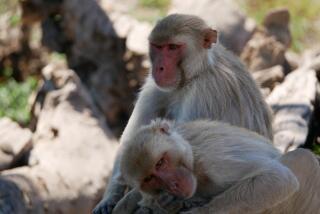Mad Cow Disease Transmitted to Monkeys, Researchers Say
- Share via
French government scientists said Thursday that they transmitted mad cow disease to monkeys and later found that the diseased primate brain tissue bore a striking resemblance to brain tissue from recent human victims of Creutzfeldt-Jakob disease.
The research offers the first direct experimental evidence to support the proposed link between the cow disease, called bovine spongiform encephalopathy, and the apparently new variant of Creutzfeldt-Jakob, which recently killed several people in the United Kingdom.
The European Union banned exports of British beef and live cattle in March after the British government acknowledged the possibility that the Creutzfeldt-Jakob victims contracted the disease by eating beef from infected cattle.
Although the new study lends weight to that link, it falls short of proving it, the French researchers acknowledged.
In their study, the researchers, Corinne Lasmezas and Jean-Philippe Deslys, said they had injected ground-up brain tissue from infected cows into two adult macaque monkeys and a newborn one in 1991.
Three years later, all three animals began to show behavioral disorders--anxiety, nervousness and depression--and developed identical brain lesions and died.
The French scientists compared their results with new cases of the human disease observed in Edinburgh, Scotland, in mid-May in sufferers under 40.
Deslys said the brain lesions were “very close, strikingly similar” and constituted “a first experimental argument for a causal link between the bovine illness and the new form of CJD in the British patients.”
The study was scheduled to be published later this month in the British journal Nature.
The journal’s editor, Dr. Philip Campbell, said it was “highly regrettable” that the researchers released their findings prior to publication. As has happened before in the crisis over mad cow disease, he said, the public is being alerted before scientists fully can scrutinize the evidence.






